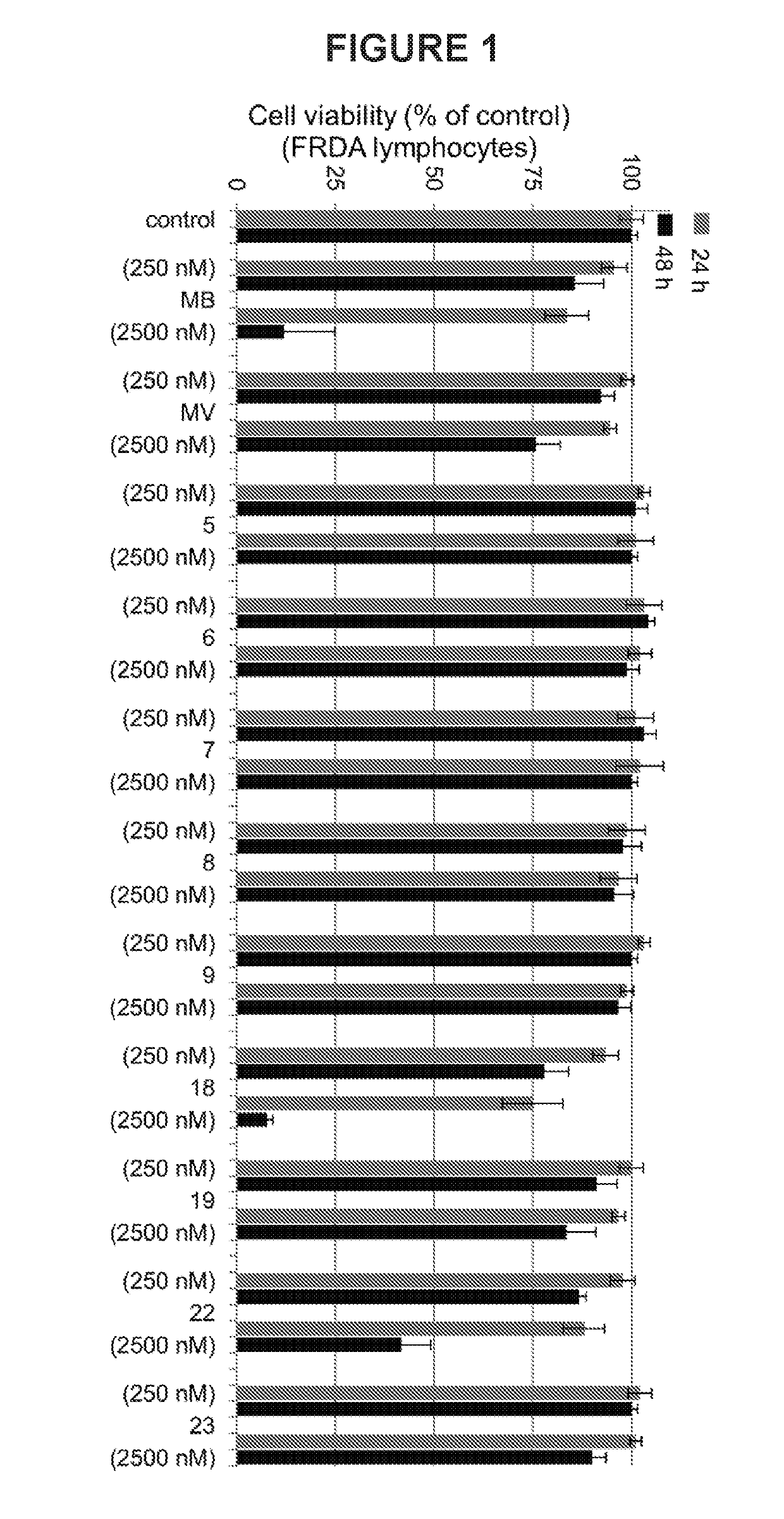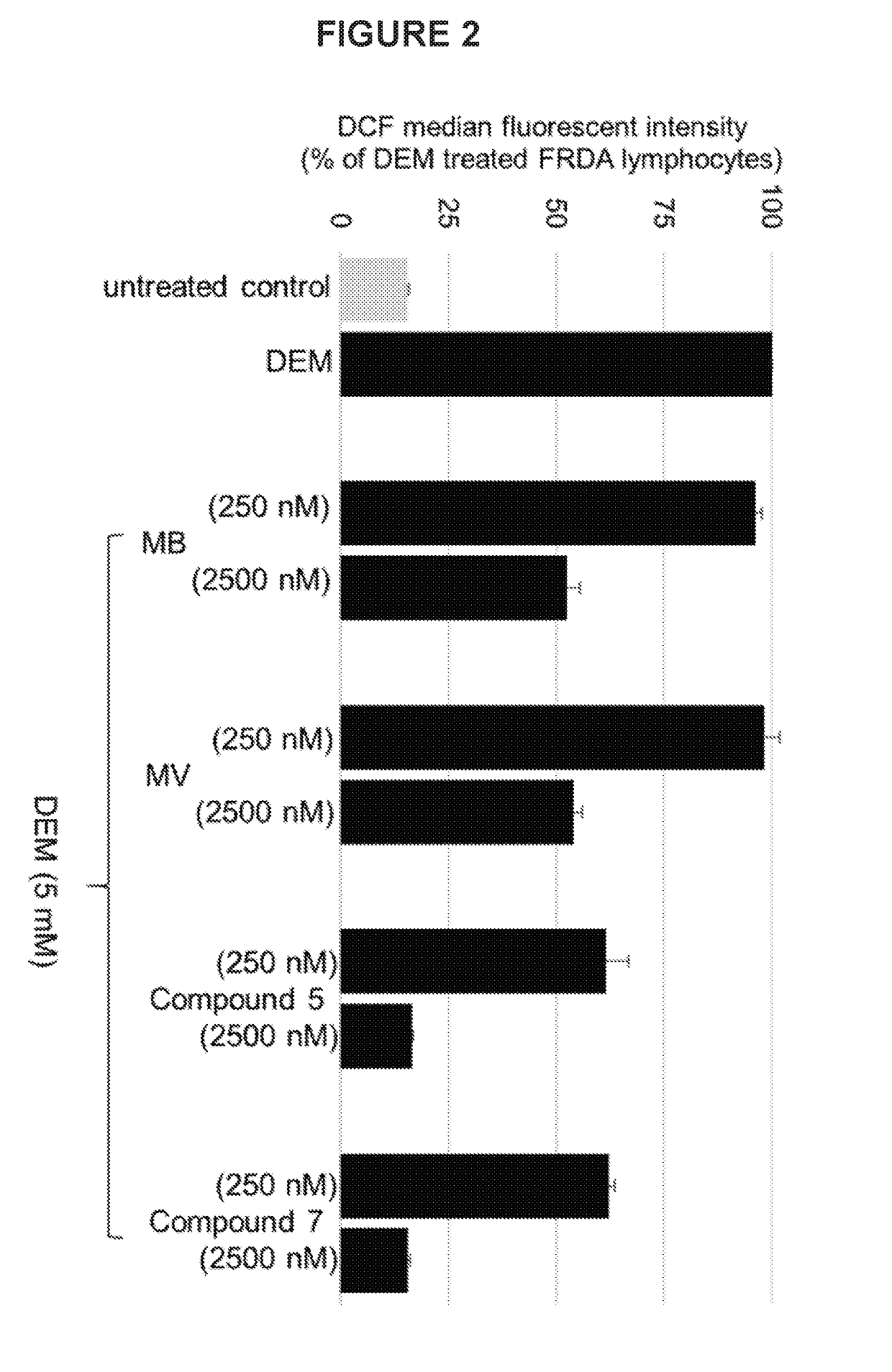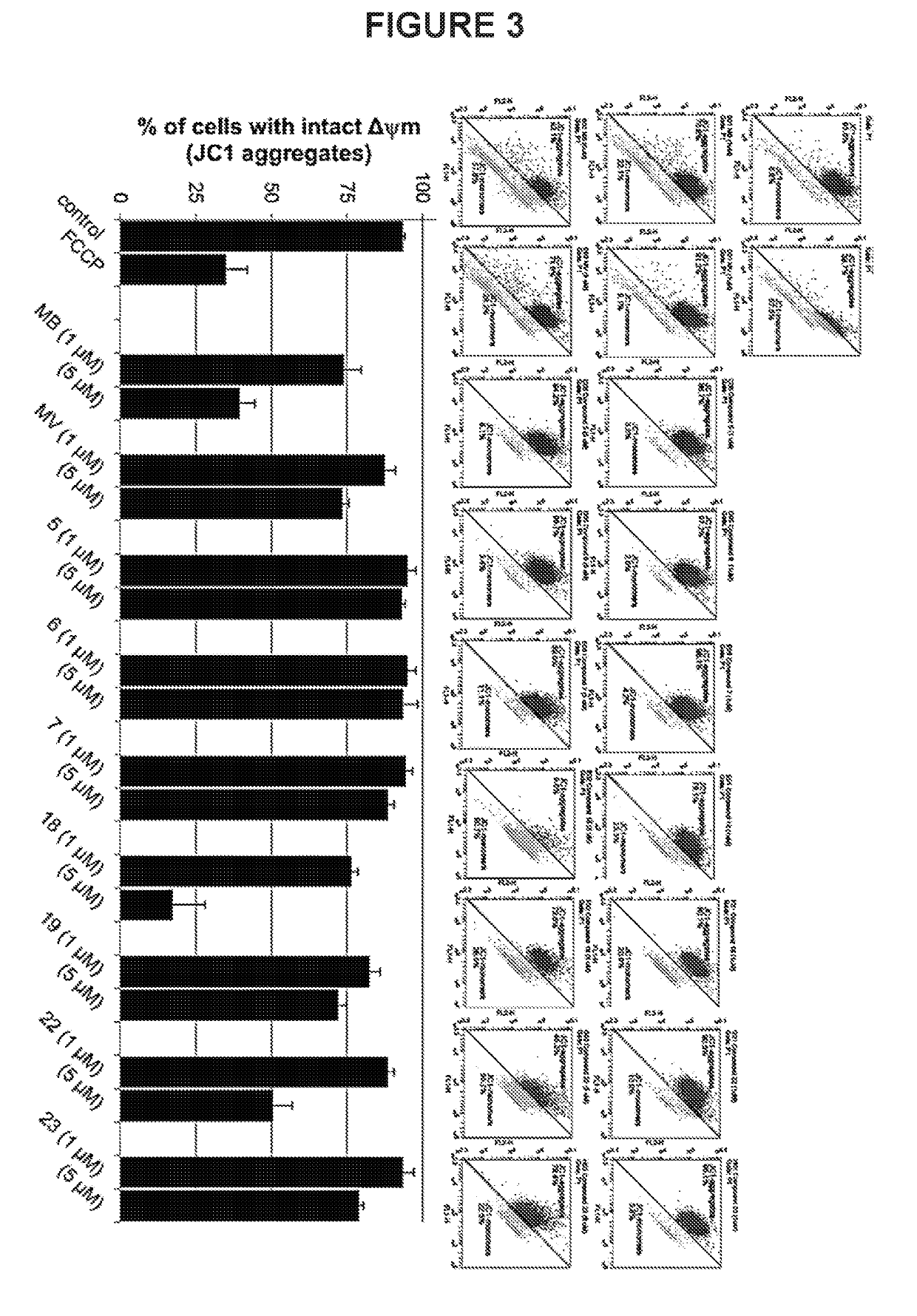Substituted phenothiazines as mitochondrial agents
a technology of phenothiazines and substituted phenothiazines, which is applied in the field of phenothiazine derivative compounds, can solve the problems of high energy level demands of neural and muscle tissues, damage to mitochondria, and high energy level demands of mitochondria, so as to reduce atp production and/or oxidative stress and/or lipid peroxidation, prevent ros-induced damage of cellular lipid membranes, and reduce mitochondrial function
- Summary
- Abstract
- Description
- Claims
- Application Information
AI Technical Summary
Benefits of technology
Problems solved by technology
Method used
Image
Examples
example 1
[0194]2-cyanophenothiazine (0.74 g, 3.30 mmol) was dissolved in 10 mL of anhydrous DMF. The mixture was cooled to 0° C. and 60% NaH (0.40 g, 9.90 mmol) was added. The dark mixture was stirred at 0° C. for an additional 15 min and Di-tent-butyl dicarbonate (0.90 g, 3.96 mmol) was added. The mixture was stirred at room temperature for 3 h and was diluted with 50 mL of brine. The aqueous layer was extracted with three 25 mL portions of ethyl acetate. The combined organic extract was dried over anhydrous MgSO4 and concentrated under diminished pressure. The crude was purified on a silica gel column (10 cm×2 cm). Elution with ethyl acetate-hexane (1:9) gave 1 as a pale yellow solid: yield 1.07 g (100%); silica gel TLC Rf 0.26 (ethyl acetate-hexane 1:9); 1H NMR (CDCl3) δ 1.49 (s, 9H), 7.16-7.20 (m, 1H), 7.28-7.33 (m, 2H), 7.40 (s, 2H), 7.49 (d, 1H, J=8.4 Hz) and 7.80 (s, 1H); 13C NMR δ 28.1, 83.1, 110.2, 118.2, 126.6, 127.2, 127.3, 127.5, 128.1,129.1, 130.3, 130.6, 137.7, 139.0, 139.1 and...
example 2
[0195]To a solution of the crude product in 10 mL of anhydrous CH2Cl2 was added 4.0 mL (4.0 mmol) of 1M DIBAL-H in toluene dropwise at −78° C. The mixture was stirred at −78° C. for 3 h and was diluted with 2N HCl. The aqueous layer was extracted with three 30 mL portions of CH2Cl2. The combined organic extract was dried over anhydrous MgSO4 and was concentrated under diminished pressure. The residue was purified on a silica gel column (7 cm×4 cm). Elution with 1:9 ethyl acetate-hexanes afforded 2 as a yellow solid: yield 0.63 g (58%); silica gel TLC Rf 0.17 (ethyl acetate-hexane 1:9); 1H NMR (CDCl3) δ 1.48 (s, 9H), 7.14-7.18 (m, 1H), 7.26-7.32 (m, 2H), 7.44 (d, 1H, J=8.0 Hz), 7.52 (d, 1H, J=7.4 Hz), 7.64 (d, 1H, J=8.0 Hz), 7.99 (s, 1H) and 9.96 (s, 1H); 13C NMR δ 28.1, 82.8, 126.5, 126.6, 127.1, 127.3, 127.4, 127.8, 128.3, 130.5, 135.1, 137.9, 139.1, 140.2 and 152.1; mass spectrum (ESI), m / z 328.0823 (M+Na)+ (C18H17NO3SNa requires m / z 328.0827).
example 3
[0196]To a solution of hexadecyltriphenylphosphonium bromide (0.64 g, 1.13 mmol) in 5 mL of anhydrous THF at −78° C. was added 1.20 mL (1.20 mmol) of 1M sodium bis-(trimethylsilyl)amide in THF dropwise. The yellow mixture was stirred at 0° C. for 3 h and was cooled to −78° C. To this bright orange suspension was added 2 (0.37 g, 1.13 mmol) dissolved in 5 mL of anhydrous THF dropwise. The light yellow mixture was stirred at 0° C. under argon atmosphere overnight and was diluted with 50 mL of brine. The aqueous layer was extracted with three 25 mL portions of ethyl acetate. The combined organic extract was dried over anhydrous MgSO4 and was concentrated under diminished pressure. The residue was purified on a silica gel column. Elution with 1:9 CH2Cl2-hexanes yielded a cis-trans mixture as a white solid.
[0197]To a solution of the cis-trans mixture (0.41 g, 0.77 mmol) in 3:7 CH2Cl2-ethanol was added palladium on carbon (26 mg, 0.16 mmol). The suspension was stirred at room temperature ...
PUM
| Property | Measurement | Unit |
|---|---|---|
| pressure | aaaaa | aaaaa |
| temperature | aaaaa | aaaaa |
| temperature | aaaaa | aaaaa |
Abstract
Description
Claims
Application Information
 Login to View More
Login to View More - R&D
- Intellectual Property
- Life Sciences
- Materials
- Tech Scout
- Unparalleled Data Quality
- Higher Quality Content
- 60% Fewer Hallucinations
Browse by: Latest US Patents, China's latest patents, Technical Efficacy Thesaurus, Application Domain, Technology Topic, Popular Technical Reports.
© 2025 PatSnap. All rights reserved.Legal|Privacy policy|Modern Slavery Act Transparency Statement|Sitemap|About US| Contact US: help@patsnap.com



